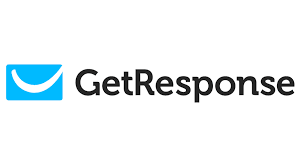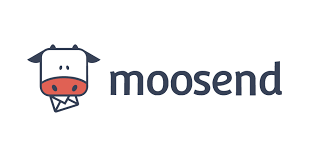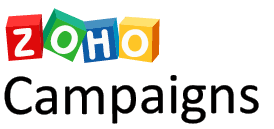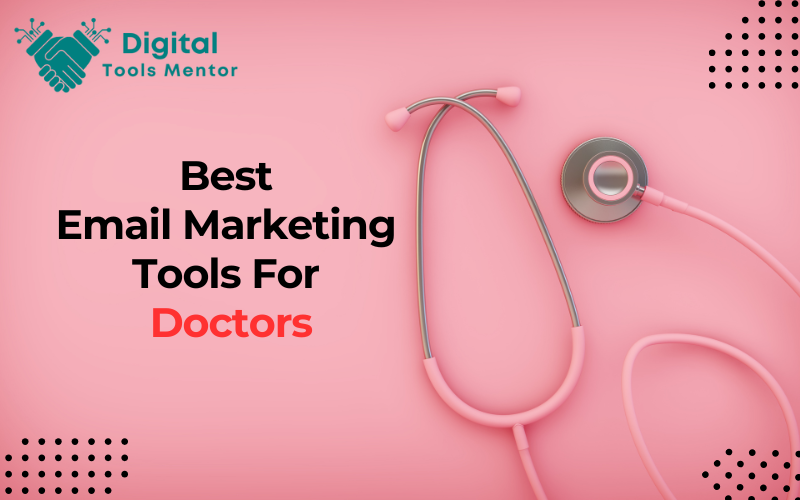9 Best Email Marketing Tools for Doctors in 2025
In today’s digital age, where technology seamlessly intertwines with daily life, the healthcare industry is not an exception to this transformation. Email marketing, often overlooked, has emerged as a vital tool for doctors and healthcare professionals. It serves not just as a medium for promotion but as a crucial channel for patient engagement and education. Before exploration of best email marketing tools for doctors, let’s see why email marketing is pivotal for doctors?
The importance of email marketing in healthcare cannot be overstated. It bridges the gap between healthcare providers and patients, enabling a flow of information that is both timely and personal. For doctors, email marketing offers a unique opportunity to maintain continuous contact with patients, share valuable health tips, updates about the practice, and information about new services or treatments. This regular communication builds a foundation of trust and loyalty, crucial in any healthcare setting.
Moreover, the landscape of patient engagement is rapidly evolving, heavily influenced by advancements in digital communication. Patients today expect more than just periodic health check-ups; they seek an ongoing relationship with their healthcare providers, one that offers convenience, accessibility, and personalized interaction. Email marketing steps in as a perfect solution to these expectations. It allows for targeted messaging, where information can be tailored to meet the specific needs and interests of individual patients, thereby enhancing the quality of care and patient satisfaction.
The role of digital communication in healthcare marketing has also seen a significant shift. With the increasing reliance on digital platforms for information, doctors must adapt to these changes to effectively reach and engage their audience. Email marketing, in this regard, is not just a tool for direct communication but a strategic asset in a broader digital marketing ecosystem that includes social media, blogs, and online patient portals.
As we venture further into 2025, the potential of email marketing in healthcare is vast and untapped. For doctors looking to expand their practice, enhance patient care, and stay ahead in the digital curve, understanding and leveraging email marketing tools is no longer just an option, but a necessity. This blog post aims to guide you through the best email marketing tools for doctors in 2025, tailored specifically for healthcare professionals, and how to utilize them effectively for patient engagement and practice growth.
Why Email Marketing is Essential for Doctors?
1. Enhanced Patient Engagement and Communication
Email marketing provides doctors with a direct line of communication to their patients, enabling them to share important information, health tips, and updates about their practice. This consistent contact helps build a stronger relationship between patients and their healthcare providers, which is crucial for patient retention and satisfaction.
- Educational Content: Doctors can use email newsletters to educate patients about common health issues, preventive measures, and lifestyle tips that can lead to better health outcomes. For example, during flu season, a doctor might send out emails advising patients on how to avoid the flu and when to get vaccinated.
- Appointment Reminders: Email can be used to send appointment reminders, which reduce no-show rates. By integrating an email marketing system with practice management software, doctors can automate these reminders, ensuring patients receive them at the right time.
- Personalized Communication: Doctors can segment their email lists based on various patient criteria (age, health conditions, past visits, etc.) to send personalized health tips or check-in emails. This personal touch can make patients feel cared for and valued, increasing their trust and loyalty to the doctor.
2. Cost-Effective Marketing and Practice Growth
Compared to other marketing channels like print, television, or online ads, email marketing is relatively inexpensive and offers a high return on investment (ROI). It allows doctors to reach a large number of patients and prospective patients without significant expenditure, making it an ideal strategy for practice growth.
- High ROI: According to various studies, email marketing often offers a high return on investment, sometimes yielding $38 for every $1 spent. This high ROI is especially beneficial for medical practices looking to expand their patient base without major investments in marketing.
- Scalability: Whether a practice is small or large, email marketing can scale to meet its needs. As the practice grows, doctors can continue to communicate effectively with an expanding patient list through automated tools that help manage and segment contacts.
- Promotions and Announcements: Email marketing can be used to inform patients about new services, changes in practice hours, or special promotions (like discounted health screenings). These announcements can attract new patients and bring existing patients back for additional services.
3. Improved Patient Care and Follow-up
Email marketing can enhance the quality of patient care by ensuring continuous engagement and follow-up. This ongoing communication can help in the management of chronic diseases, post-operative care, and general wellness.
- Follow-up Care: After visits, doctors can use email to follow up with patients regarding their recovery, remind them about medication schedules, or advise on any necessary steps they need to take. This helps in better post-visit care and reduces readmission rates.
- Chronic Disease Management: For patients with chronic conditions like diabetes or hypertension, regular emails with personalized advice can help manage these conditions more effectively. These emails can include diet tips, reminders to check blood pressure or blood sugar levels, and encouragement to maintain a healthy lifestyle.
- Feedback Collection: Emails can also be used to gather patient feedback through surveys. This feedback is invaluable for improving service delivery and patient satisfaction. Additionally, positive feedback can be used as testimonials to attract new patients.
In short, email marketing allows doctors to maintain a closer relationship with their patients, enhance the effectiveness of their medical advice and care, and grow their practices economically. By adopting a strategic approach to email marketing, doctors can achieve better health outcomes and business success.
9 Best Email Marketing Tools for Doctors in 2025
Following are the 9 best email marketing tools for doctors in 2025.
1. HubSpot
Key Features
- All-in-One Marketing Platform: Integrates email marketing with CRM, social media, content management, and analytics.
- Personalization and Segmentation: Allows targeted emails based on user behavior, preferences, and previous interactions.
- Automation: Offers robust automation capabilities for streamlined and efficient campaign management.
- Detailed Analytics: Provides comprehensive reporting tools to track the success of email campaigns.
- User-Friendly Interface: Easy-to-use drag-and-drop email builder and pre-designed templates.
Pricing
- HubSpot offers a free plan with basic features.
- Starter Plan: Starts at $45/month, includes basic CRM features.
- Professional Plan: Starts at $800/month, more advanced automation and customization options.
- Enterprise Plan: Starts at $3,200/month, offers full scalability and advanced features.
Pros
- Comprehensive Solution: Combines email marketing with other marketing tools and CRM.
- Ease of Use: Intuitive design and easy navigation.
- High Customization: Offers a high degree of personalization in campaigns.
- In-Depth Analytics: Detailed reports to measure and improve campaign performance.
Cons
- Price: Can be expensive, especially for the more advanced plans.
- Learning Curve: The vast range of features might be overwhelming for beginners.
- Integration Costs: Some integrations may require additional expenses.
Why HubSpot Is a Best Choice for Doctors Email Marketing?
HubSpot stands out as a top choice for doctors due to its comprehensive set of tools that go beyond just email marketing. Its integration with CRM allows for a holistic approach to patient engagement and communication. The platform’s ability to personalize and segment communications is particularly useful in healthcare, where tailored patient communication is key. Moreover, its user-friendly interface ensures that even those without technical expertise can create effective campaigns. While the pricing can be on the higher end, the value delivered through its all-in-one approach and detailed analytics makes it a worthy investment for practices looking to enhance their digital marketing strategies significantly.

2. ActiveCampaign
Key Features
- Advanced Email Automation: Enables complex automation workflows tailored to specific patient interactions and behaviors.
- CRM Integration: Seamlessly combines email marketing with customer relationship management.
- Segmentation Capabilities: Allows for detailed segmentation of patient lists based on various criteria.
- Dynamic Content: Offers the ability to create emails with content that changes based on user interactions.
- Extensive Template Library: A wide range of customizable email templates suitable for various purposes.
Pricing
- Lite Plan: Starts at $9/month, includes basic email marketing features.
- Plus Plan: Starts at $49/month, adds CRM and lead scoring.
- Professional Plan: Starts at $129/month, includes advanced features like site messaging.
- Enterprise Plan: Custom pricing, offers complete customization and dedicated support.
Pros
- Sophisticated Automation: Highly regarded for its powerful automation capabilities.
- User-Friendly Interface: Easy to navigate with a clean design.
- Robust Reporting: Detailed analytics to track and optimize campaign performance.
- Excellent Customer Support: Known for its responsive and helpful support team.
Cons
- Complexity: Some users may find the range of features and options overwhelming.
- Pricing Tiers: Advanced features are locked behind higher pricing tiers.
- Integration Costs: Additional costs for integrating with certain third-party applications.
Why ActiveCampaign Is a Best Choice for Doctors Email Marketing?
ActiveCampaign is an excellent choice for doctors primarily due to its advanced automation and segmentation capabilities, allowing for highly personalized patient communication. This personalization is crucial in the healthcare sector where patient engagement needs to be relevant and sensitive to individual health situations. The integration of email marketing with CRM also helps in maintaining a comprehensive view of patient interactions, enhancing relationship management. While there is a learning curve due to its complexity, the depth of features it offers makes it ideal for practices looking to implement sophisticated email marketing strategies. Its scalable plans also mean that it can grow with the practice, making it a versatile and future-proof choice.

3. GetResponse
Key Features
- Email Automation: Sophisticated tools for creating automated email sequences based on user actions.
- Segmentation and Personalization: Allows targeting specific patient groups with personalized content.
- Landing Pages and Webinars: Integrated tools for creating landing pages and hosting webinars, expanding communication avenues.
- A/B Testing: Enables testing different email versions to see which performs better.
- Advanced Analytics: Tracks email campaign performance with detailed reports and metrics.
Pricing
- Basic Plan: Starts at $15/month, includes email marketing and autoresponders.
- Plus Plan: Starts at $49/month, adds automation builders, webinars, and contact scoring.
- Professional Plan: Starts at $99/month, offers advanced automation and segmentation features.
- Max Plan: Custom pricing, includes tailored solutions and dedicated support.
Pros
- All-in-One Platform: Offers a wide range of marketing tools beyond email marketing.
- Ease of Use: User-friendly interface, suitable for beginners and experts alike.
- Integration Options: Extensive integration capabilities with other software and tools.
- Affordable Pricing: Competitive pricing, especially for the feature set offered.
Cons
- Limited Customization: Some templates and design options are less customizable compared to competitors.
- Automation Complexity: The learning curve for mastering the automation tools.
- Support Variability: Customer support quality can vary depending on the plan.
Why GetResponse Is a Best Choice for Doctors Email Marketing?
GetResponse is an ideal choice for doctors due to its comprehensive and versatile marketing toolkit, which extends beyond email marketing to include landing pages and webinar hosting. This makes it not just a tool for communication, but also for education and patient engagement. The platform’s ease of use ensures that healthcare professionals can focus on their practice without worrying about technical complexities. Additionally, its competitive pricing makes it an attractive option for small to medium-sized practices. The advanced analytics and A/B testing capabilities are key for doctors to understand and optimize their patient communication strategies, ensuring that their messages are both effective and engaging.

4. Omnisend
Key Features
- Omnichannel Marketing: Integrates email marketing with SMS and social media channels for a unified approach.
- Automation Workflows: Customizable workflows for different segments of the patient base, enhancing targeted communication.
- Segmentation Tools: Advanced segmentation capabilities to tailor messages based on patient behavior and preferences.
- Dynamic Content: Ability to create emails with content that changes based on user interactions, enhancing personalization.
- Comprehensive Reporting: Detailed analytics to track the performance of campaigns across different channels.
Pricing
- Free Plan: Offers basic email marketing features with a limited send limit.
- Standard Plan: Starts at $16/month, includes SMS campaigns and automation.
- Pro Plan: Starts at $99/month, adds advanced reporting and more sophisticated features.
- Enterprise Plan: Custom pricing, provides full feature access and dedicated support.
Pros
- Multichannel Capabilities: Allows for a diverse and integrated approach to patient communication.
- User-Friendly Interface: Easy to navigate, suitable for those without technical expertise.
- Robust Automation: Strong automation tools to create efficient and personalized email campaigns.
- Comprehensive Analytics: Helps in understanding and optimizing campaign effectiveness.
Cons
- Limited Customization in Free Plan: Advanced customization features are limited in the free version.
- Learning Curve: Some features may require a bit of learning, especially for beginners.
- Cost for Advanced Features: Higher tiers needed for full functionality, which might be costly for smaller practices.
Why Omnisend Is a Best Choice for Doctors Email Marketing?
Omnisend is a best choice for doctors who are looking to integrate their email marketing efforts with other channels like SMS and social media. This omnichannel approach is particularly useful in healthcare where patient engagement can be enhanced through multiple touchpoints. The platform’s ease of use and strong automation capabilities allow for effective and efficient communication with patients, ensuring that messages are both timely and relevant. Additionally, the advanced segmentation and dynamic content features are essential for personalizing communication, a critical aspect in the healthcare industry. Omnisend’s ability to provide comprehensive analytics across multiple channels also makes it a powerful tool for doctors to measure and understand the impact of their marketing efforts, ensuring they can make data-driven decisions for improved patient engagement.

5. MailerLite
Key Features
- Intuitive Email Editor: User-friendly drag-and-drop editor for creating professional emails without needing technical skills.
- Automation Features: Automated workflows for sending targeted and timely emails to patients.
- Advanced Segmentation: Allows for precise targeting by segmenting audiences based on their behavior and preferences.
- Landing Pages and Pop-ups: Integrated tools to create landing pages and pop-ups for additional patient engagement opportunities.
- Detailed Analytics: Provides comprehensive reporting on email campaign performance.
Pricing
- Free Plan: Up to 1,000 subscribers and 12,000 emails per month.
- Paid Plans: Start at $10/month, pricing increases based on the number of subscribers. Higher plans offer advanced features like automation and segmentation.
Pros
- Affordability: Offers a robust free plan and reasonably priced paid options, making it accessible for practices of all sizes.
- Ease of Use: Its intuitive interface is ideal for those new to email marketing.
- Effective Automation and Segmentation: Enhances the ability to send personalized and relevant communications.
- Good for Beginners: Simplified features make it a great starting point for those new to email marketing.
Cons
- Limited Design Options: Some users might find the template and design options more limited compared to other platforms.
- Basic Automation: While effective, the automation features are not as advanced as some higher-end competitors.
- Support on Free Plan: Limited customer support options available for the free plan.
Why MailerLite Is a Best Choice for Doctors Email Marketing?
MailerLite stands out as a best choice for doctors, particularly for those who are new to email marketing or have smaller practices. Its affordability, combined with an intuitive user interface, makes it an accessible option for healthcare professionals without extensive marketing experience. The platform offers sufficient automation and segmentation capabilities to effectively engage patients with personalized communication, which is key in the healthcare sector. Despite some limitations in design and advanced features, MailerLite’s balance of ease of use, functionality, and cost makes it an excellent option for doctors looking to begin or enhance their email marketing efforts without a significant investment.

6. SendinBlue (Brevo)
Key Features
- Email Campaigns: Advanced tools for creating, personalizing, and sending email campaigns.
- SMS Marketing: Integrates SMS marketing, allowing for broader communication strategies.
- Transactional Emails: Capable of sending transactional emails, such as appointment reminders.
- Automation: Offers workflow automation for sending targeted emails based on user actions.
- Contact Segmentation: Precise segmentation options to target specific patient groups effectively.
Pricing
- Free Plan: Includes a limited number of emails per day.
- Lite Plan: Starts at $25/month, includes no daily sending limit and email support.
- Premium Plan: Starts at $65/month, adds features like marketing automation, landing pages, and Facebook ads.
- Enterprise Plan: Custom pricing, offers advanced features and personalized support.
Pros
- Versatility: Combines email and SMS marketing, suitable for comprehensive communication strategies.
- User-Friendly Design: Intuitive interface makes it easy to use for users of all skill levels.
- Scalable Plans: Offers a range of plans to suit various needs and sizes of practices.
- Robust Automation Features: Enhances the effectiveness and efficiency of marketing campaigns.
Cons
- Limited Free Plan: The free version has limited features and a daily email sending cap.
- Template Design: Some users may find the template designs less sophisticated compared to competitors.
- Learning Curve: Initial setup and utilization of all features can take some time to master.
Why Brevo Is a Best Choice for Doctors Email Marketing?
SendinBlue (Brevo) is an excellent choice for doctors due to its blend of email and SMS marketing capabilities, which is crucial in today’s multi-channel communication environment. The platform’s emphasis on automation and segmentation allows for highly personalized and targeted communication with patients, essential for building trust and engagement in healthcare. Its scalable plans mean that it can accommodate the growing needs of a medical practice, making it a versatile and future-proof option. Despite some limitations in its free plan and template designs, SendinBlue’s user-friendly interface and robust feature set make it a strong contender for doctors looking to enhance their patient communication and engagement strategies.

7. Moosend
Key Features
- Advanced Email Automation: Streamline patient communication with automated email sequences based on specific behaviors and triggers.
- Customizable Templates: A wide array of templates that can be tailored to fit the specific needs and branding of a medical practice.
- Segmentation Tools: Allows for precise segmentation of email lists, ensuring targeted and relevant communication with different patient groups.
- Real-time Analytics: Track the performance of email campaigns with detailed, real-time reports.
- Landing Pages and Subscription Forms: Create custom landing pages and forms to capture patient information and grow email lists.
Pricing
- Free Plan: Includes basic features with a limit on the number of subscribers and email sends.
- Paid Plans: Pricing is based on the number of subscribers, starting from around $10/month for up to 1,000 subscribers. Higher plans offer more advanced features and larger subscriber limits.
Pros
- Ease of Use: Known for its user-friendly interface, making it accessible even for those with limited technical expertise.
- Affordable Pricing: Competitive pricing, especially for small to medium-sized practices.
- Effective Segmentation: Enhances the ability to tailor messages for different patient demographics and needs.
- Robust Analytics: Provides valuable insights into campaign effectiveness and patient engagement.
Cons
- Limited Integrations: May not offer as many integrations with other tools and platforms compared to larger competitors.
- Simpler Automation Features: While effective, the automation tools might not be as advanced as those offered by more premium services.
- Template Variety: Some users might find the selection of templates and design options less extensive.
Why Moosend Is a Best Choice for Doctors Email Marketing?
Moosend is an ideal choice for doctors, particularly those in smaller practices or just starting with email marketing, due to its simplicity and affordability. The platform offers a user-friendly experience without sacrificing key functionalities like segmentation and automation, which are essential for personalized patient communication. The real-time analytics feature is a significant asset, allowing doctors to make data-driven decisions to improve their email campaigns. While it may not have the extensive integration capabilities of larger platforms, its ease of use, cost-effectiveness, and core features make Moosend a practical and efficient tool for healthcare professionals looking to enhance their digital communication efforts.

8. Zoho Campaigns
Key Features
- Customizable Email Templates: Wide range of templates that can be tailored to fit the branding and communication needs of a medical practice.
- Automated Email Sequences: Set up automated emails for patient follow-ups, health tips, appointment reminders, and more.
- Audience Segmentation: Effective tools for segmenting email lists to ensure targeted and relevant communication.
- A/B Testing: Test different versions of emails to determine which performs better with your audience.
- Integration with Zoho CRM: Seamless integration with Zoho CRM for a unified approach to patient management and communication.
Pricing
- Free Plan: Limited features with a cap on the number of emails and subscribers.
- Standard Plan: Starts at $3/month, pricing based on the number of subscribers and includes basic email marketing features.
- Professional Plan: More advanced features like autoresponders and workflows, priced according to subscriber count.
Pros
- Integration with Zoho Suite: Ideal for those already using Zoho products, ensuring a cohesive ecosystem.
- User-Friendly Interface: Easy to navigate, suitable for beginners.
- Cost-Effective: Offers one of the most competitive pricing structures in the market.
- Effective Segmentation and Personalization: Enhances the relevance of communication with patients.
Cons
- Limited Template Designs: Some users may find the design options less extensive compared to other platforms.
- Learning Curve with Advanced Features: Getting the most out of the platform may require some initial learning.
- Support Quality: The level of customer support can vary, which might be a concern for users requiring frequent assistance.
Why Zoho Campaigns Is a Best Choice for Doctors Email Marketing?
Zoho Campaigns is a great choice for doctors, especially those who are already part of the Zoho ecosystem, as it offers seamless integration with other Zoho applications like Zoho CRM. This integration is highly beneficial for managing patient relationships and communications efficiently. The platform’s user-friendly interface, combined with its cost-effective pricing, makes it accessible to practices of all sizes. While it may have some limitations in design versatility and a learning curve for more advanced features, its robust segmentation, personalization capabilities, and overall value for money make Zoho Campaigns a strong option for healthcare professionals looking to streamline their email marketing efforts.

9. EmailOctopus
Key Features
- Simple Email Campaign Management: Easy-to-use tools for creating and sending out email campaigns.
- Automation: Set up automated email sequences for efficient patient communication.
- Customizable Templates: A range of templates that can be modified to suit the specific needs of a medical practice.
- List Segmentation: Segment email lists based on patient demographics or behavior for targeted communication.
- Integration with Third-party Apps: Compatible with various applications and services for enhanced functionality.
Pricing
- Free Plan: Offers basic features with a limit on the number of emails and subscribers.
- Pro Plan: Starts at $20/month, pricing increases with the number of subscribers, offering more advanced features and higher sending limits.
Pros
- Cost-Effective: Attractive pricing, especially beneficial for small to mid-sized practices.
- Ease of Use: Intuitive interface, ideal for those new to email marketing.
- Effective for Basic Needs: Provides essential features needed for effective email marketing without complexity.
- Good Integration Options: Allows for easy integration with other tools, enhancing overall functionality.
Cons
- Limited Advanced Features: May lack some of the more sophisticated features offered by higher-end competitors.
- Template Variety: Limited selection of templates compared to other platforms.
- Support Options: Customer support might not be as extensive as in more premium services.
Why EmailOctopus Is a Best Choice for Doctors Email Marketing?
EmailOctopus is an excellent choice for doctors, particularly those managing smaller practices or those who are budget-conscious, due to its simplicity and affordability. The platform’s straightforward approach to email marketing makes it easy for healthcare professionals to communicate effectively with their patients without needing to navigate complex features or tools. While it may not offer the breadth of advanced features as some other tools, its core functionalities are more than sufficient for most email marketing needs in a healthcare setting. The ability to integrate with other applications adds to its versatility, making EmailOctopus a practical and efficient choice for doctors seeking an uncomplicated yet effective email marketing solution.

Tips for Creating Effective Physician Email Marketing Campaigns
1. Keep It Clear and Concise
Medical information can be complex, but your emails should be easy to understand. Use clear, jargon-free language to convey your message.
2. Use a Compelling Subject Line
The subject line is your first impression. Make it engaging and relevant to encourage opens.
3. Personalize Your Emails
Address patients by name and tailor the content to their interests or needs. Personalization increases engagement and makes your emails more relatable.
4. Include a Call-to-Action (CTA)
Whether it’s booking an appointment, reading a blog post, or following you on social media, a clear CTA guides patients on what to do next.
5. Provide Value
Share useful health tips, updates about your practice, or information about new treatments and services. Content should be beneficial to the reader.
6. Use Visuals
Break up text with relevant images or infographics. Visuals make the content more engaging and easier to digest.
7. Maintain Brand Consistency
Ensure your emails reflect your practice’s branding in terms of tone, colors, and logo for easy recognition.
8. Test and Optimize
Use A/B testing for different elements like subject lines, email layouts, and CTAs to see what works best with your audience.
Understanding Your Audience: Tips for Segmenting Your Patient List
1. Segment by Demographics
Age, gender, and location are basic ways to segment your list for more relevant communication.
2. Consider Health Interests or Conditions
Segmenting by health interests or specific conditions allows you to send targeted information that patients find relevant.
3. Behavioral Segmentation
Look at how patients interact with your emails and website. Segment based on their actions, like those who frequently open emails or have clicked on certain links.
4. Patient Journey Stage
Segment your list based on where patients are in their healthcare journey, such as new patients, regular visitors, or those who haven’t visited in a while.
Integrating with Other Digital Marketing Strategies (Social Media, Blogs)
1. Cross-Promote Content
Share snippets or links to your latest blog posts in your emails. Likewise, use social media to tease upcoming newsletters or email-exclusive content.
2. Unified Messaging
Ensure your messaging is consistent across all channels. If you’re focusing on a particular health topic in your emails, echo that on your social media and blog.
3. Use Email to Boost Engagement
Encourage your email subscribers to follow you on social media for more regular updates or to check out your blog for more in-depth information.
4. Track and Analyze
Use analytics to understand which channels are driving traffic and engagement. This insight can help you refine your strategy across all platforms.
By following these tips, you can create effective email campaigns that not only engage and inform your patients but also integrate seamlessly with your broader digital marketing strategy, amplifying your reach and impact.
Measuring the Success of Your Email Campaigns
Key Metrics to Track
1. Open Rates
This metric indicates how many recipients are opening your emails. A high open rate generally signifies compelling subject lines and a strong sender reputation.
2. Click-Through Rates (CTR)
CTR measures how many people clicked on links within your email. It reflects the relevance and appeal of your content and call-to-actions.
3. Conversion Rates
This tracks how many recipients took the desired action after clicking a link in your email, such as booking an appointment or downloading a health guide.
4. Bounce Rates
Monitor how many of your emails are not being delivered. High bounce rates may indicate outdated email lists or issues with your email server.
5. Unsubscribe Rates
Keeping an eye on how many people unsubscribe can help you gauge overall recipient satisfaction and content relevance.
6. Patient Feedback
Direct feedback from patients, through surveys or replies, can provide qualitative insights into how your email content is perceived and its impact.
Utilizing Analytics to Improve Future Campaigns
1. Identify Trends
Use analytics to understand what types of content resonate with your audience. For instance, do educational articles get more clicks, or are patients more responsive to updates about your practice?
2. Segment and Target
Based on engagement patterns, segment your audience for more targeted and personalized campaigns. Tailoring content to specific groups can significantly increase relevance and effectiveness.
3. Optimize Send Times
Experiment with different sending times and days to find when your patients are most likely to engage with your emails.
4. A/B Testing
Regularly test different elements of your emails (like subject lines, images, and layout) to see what works best and refine your approach based on these results.
5. Respond to Feedback
If patient feedback indicates a preference for certain types of content or delivery frequency, adjust your strategy accordingly.
Legal and Ethical Considerations
Ensuring Compliance with Healthcare Communication Regulations
- Understanding HIPAA and Other Regulations: In the U.S., the Health Insurance Portability and Accountability Act (HIPAA) sets strict standards for protecting patient health information. It’s crucial to understand and comply with HIPAA and other local healthcare communication laws to avoid legal repercussions.
- Using HIPAA-Compliant Email Services: Ensure that your email marketing service provider offers HIPAA-compliant solutions, including secure data storage and transmission.
- Regular Training and Updates: Keep your team regularly trained and updated on compliance requirements to avoid accidental breaches of patient confidentiality or other legal issues.
Balancing Promotional Content with Informational and Educational Material
- Prioritizing Patient Education: While email marketing can be used for promotional purposes, priority should be given to informational and educational content that benefits the patient’s health and wellbeing.
- Transparent and Ethical Marketing: Any promotional content should be transparent and ethical. Avoid exaggerated claims about treatments or services, and always provide clear, factual information.
- Respecting the Patient’s Choice: Give patients the option to opt-in or out of different types of emails, whether promotional or educational, to respect their preferences and autonomy.
Privacy and Security in Patient Communication
- Securing Patient Data: Implement strong security measures to protect patient data. This includes using encrypted email services and secure patient portals for sensitive communications.
- Consent and Confidentiality: Always obtain consent before sending any form of communication and ensure that patient confidentiality is maintained in all emails. Avoid sharing any personal health information in emails unless it’s through a secure and compliant system.
- Being Mindful of Sensitive Information: Be cautious when sending emails about sensitive health topics. General information can be shared broadly, but specific advice or information should be handled with discretion to avoid any privacy concerns.
It’s vital for healthcare providers to navigate the intersection of digital marketing and patient communication with a strong commitment to legal and ethical standards. This includes staying compliant with relevant laws, prioritizing the educational value of content, and upholding the highest standards of privacy and security. By doing so, doctors not only protect themselves legally but also foster trust and credibility with their patients.
Read 23 Best Email Marketing Platforms in 2025
Best Email Marketing Tools for Doctors: Conclusion
The exploration of email marketing tools and strategies underscores a pivotal truth in modern healthcare: digital communication is no longer a luxury, but a necessity. For doctors and healthcare professionals, the thoughtful implementation of email marketing can transform the way they connect, educate, and build relationships with their patients.
Email marketing, with its unique blend of personalization, accessibility, and efficiency, offers a powerful medium for doctors to extend their care beyond the confines of the traditional office visit. It enables continuous patient engagement, delivering valuable health information, reminders, and updates directly into the hands of those who need it. This ongoing connection not only enhances patient satisfaction but also plays a crucial role in fostering better health outcomes.
Moreover, in an era where digital literacy is increasingly important, embracing email marketing and other digital tools signifies a practice’s commitment to innovation and patient-centered care. The integration of these tools into everyday practice management is not just about keeping up with technological trends; it’s about deepening the doctor-patient relationship in ways that are relevant, effective, and responsive to the needs of a digitally connected patient base.
As we look towards the future, the message is clear: for healthcare professionals seeking to improve patient care and engagement, the digital realm offers fertile ground for growth and connection. Email marketing, with its vast potential for personalization, education, and communication, stands as a cornerstone in this digital landscape. By harnessing its power, doctors can not only enhance their practice’s efficiency and reach but also contribute to a more informed, engaged, and healthy patient community.




